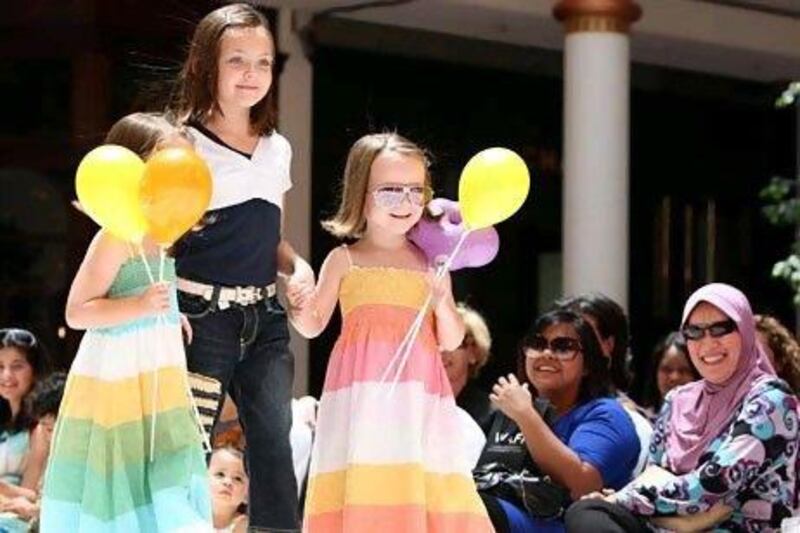Bubbles & Giggles, Pitter Patter and Gingersnaps are just a few of the creatively named children's fashion stores in Dubai Mall.
Overlooking the aquarium on the second floor, shoals of pram-pushing mothers nip in and out of brightly coloured stores that make up a corridor of children's fashion.
Lesser-known brands such as Petit Bateau, Petits Petons and Little Castle ply their trade next to world-famous designer names such as Ralph Lauren and Armani Kids.
This busy corridor of more than 20 children's shops is growing, with Lovely Lace Baby, Dior Kids and Gucci Kids all soon to open glamorous stores for equally glamorous mothers and their fashion-conscious offspring.
"Parents want to see their children dressed well, and even the children are becoming very brand-conscious," says Manmeet Padam, the brand manager for Angels, a home-grown designer children's store run by the Rivoli Group. "It's a big market for the fashion houses."
Angels, which has nine stores in the UAE, is a multi-branded retailer, selling French, Italian and American products, including Baby Dior, Burberry, Kenzo Kids, Ferrari and Hugo Boss.
Clothing prices in the store start at Dh250 (US$68) and go up to Dh2,500.
"There's an increase in activity in the market. It's only going to get bigger and better," says Ms Padam.
But the market is already huge. Parents spent an estimated $1 billion on children's designer clothing and footwear last year in the Emirates, according to the research company Euromonitor.
Moreover, the total spent on children's fashion, not just designer clothing, is estimated to run into billions as the big operators, such as BabyShop and Mothercare, dominate the mass market.
"Buying children's designer clothing is most common within the local community and the Arab expatriates who are happy to splash out on their children when they can afford it," says Sana Toukan, an analyst at Euromonitor. "Children's designer outerwear in the UAE saw a healthy 16 per cent growth in 2010 on the previous year as the economy recovered, leaving people with more disposable income to spend on their children."
Ms Toukan has not yet firmed up her figures for last year, but stores such as Angels have reported sales growth of more than 30 per cent for last year compared with 2010.
Retailers have quickly recognised what the spending trend can mean for their bottom lines, opening stores not just in Dubai Mall, but also in shopping centres in Abu Dhabi, Qatar and Saudi Arabia.
The Chalhoub Group, one of the biggest luxury players in the Middle East, is rolling out its home-grown children's concept called Katakeet, Arabic for "chicks".
In the mass-market segment, Liwa Trading Enterprises, an Abu Dhabi retailer, plans to open 50 to 60 children's stores in the GCC in the next few years, having signed franchise agreements with the Spanish retailers Gocco and Charanga.
"Every international brand wants to move here," says Aniss Baobaid, the general manager of Liwa Trading. "They are basically creating the same fashionability of the adult clothing, but for kids."
As the market grows and fashion houses push the trend, children are also becoming more brand-aware.
On a catwalk in Dubai Mall last Wednesday evening, the latest cocktail dresses, tuxedos and dinner jackets - all for children - were on display. Arranged by Majestic Kids, a store owned by International Business Group Majestic, the event had five different themes: chic afternoon couples; beachwear; glitter and jeans; fresh and snobbish; and evening occasions.
It seems children also need wardrobes fit for any occasion.
As she rushes around Ralph Lauren Kids in Dubai Mall, Katja Kern, a housewife from Germany who lives in Dubai, explains that her two girls, who are 3 and 5, are aware of what is fashionable and what is destined for the charity shop.
"My girls are very conscious of what they like," she says, just after explaining to the shop assistant that her daughters will not like the colours suggested for polo shirts. "They have colours and princess ideas in mind, which they learn in school and not at home. I do not make them aware of brands. I'm very price-conscious and buy a lot in sales."
Saleh Suhail, an Emirati from Abu Dhabi, is also wandering around the children's corridor, pushing his 2-month-old baby boy in a pram.
He is acutely aware that his son will quickly outgrow his clothes.
"I have bought a lot from BabyShop. I cannot buy all my clothes from [designer] brands," Mr Suhail says. "They grow up so fast and their size is always changing."
Despite parents' value-conscious approach to shopping for their children, retailers say the market for newborn to 4 years old is one of the most lucrative, because, as Mr Suhail says, young children grow quickly.
"The main business is from zero months to 12 years old, and we can say that 50 per cent of the business is generated from sales for 0 months to 4 years, and in this case the parents are the decision-makers," says Rania Masri, the operations manager at the Chalhoub Group retail division.
twitter: Follow and share our breaking business news. Follow us





